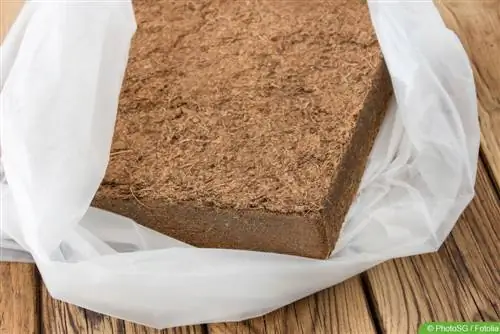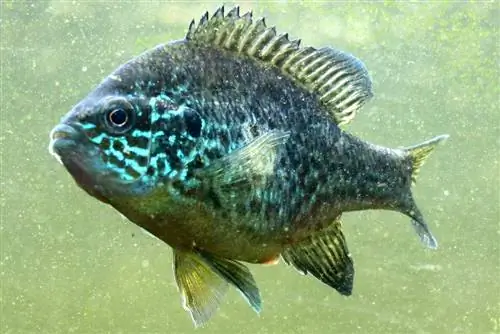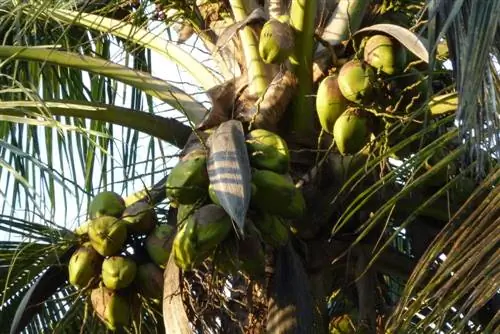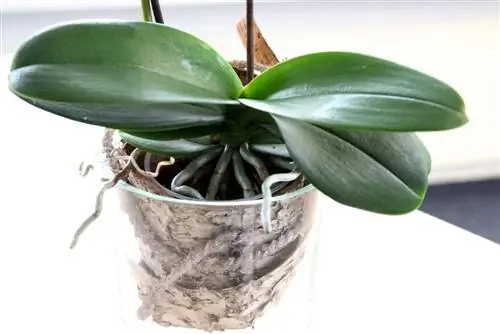- Author admin [email protected].
- Public 2023-12-17 03:39.
- Last modified 2025-01-24 12:45.
Coconut soil or coconut humus, as it is also called, has numerous advantages and is therefore now used comparatively frequently. Above all, it has earned a permanent place among gardeners and hobby gardeners as a more environmentally friendly alternative to peat. However, if it becomes moldy, you still need to act quickly in order to be able to save the plants inside and prevent the mold from spreading.
Prepare coconut fiber
Coconut fiber or coconut humus is often sold dried in the form of pressed briquettes and, more rarely, loose. This means you can mix it yourself with the desired soil. However, you can now also find ready-made mixtures on the market that are specifically tailored to certain types of plants or purposes. For example as:
- Substrate for terrariums
- growing soil
- Orchid soil
In any case, the coconut soil should be prepared appropriately before use to prevent the formation of mold. If it is a pressed briquette, it must first be soaked in water. Heat treatment should then be carried out to kill any mold spores and other germs that may be present. The procedure is as follows:
- Drain soil well or squeeze to remove excess water.
- Spread the soil as thinly as possible on a baking tray lined with baking paper.
- Let it heat up at a temperature of at least 120°C for one hour. Alternatively, the coconut soil can also be heated in the microwave. About ten minutes is enough here.
Tip:
It is optimal if the heat treatment is carried out not only with the coconut soil, but also with the substrate that is to be mixed in.
Proper moisture content
Coconut fibers generally do not mold because they have mild fungicidal properties. If mold does form, it is often caused by excessive moisture content. Coconut humus should therefore never be used dripping wet, but should be squeezed out before use. Adapted watering is also one of the preventive measures against mold formation in the planter.
Insert drainage
So that one or two “watering accidents” of the substrate and plant can be forgiven, the container needs sufficient drainage and the water must be able to drain away accordingly. A simple solution is plant pots that already have holes for water drainage. In addition, ceramic shards or coarse gravel can be filled into the flower pot as a soil layer. This creates a spacer between the water and the substrate.
Check humidity
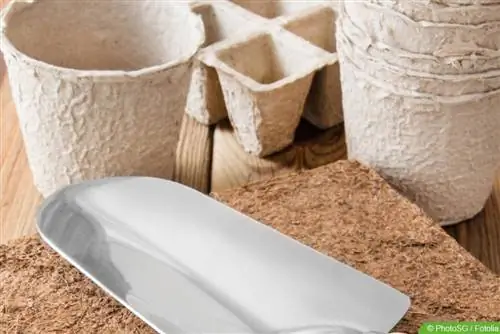
If mold is found on the surface of the coconut humus, this can also be due to excessive humidity at the location. 40 to 60 percent is ideal at room temperatures between 17 and 23 °C. If it is significantly more humid, mold is almost inevitable, and not just on the coconut fiber substrate. The humidity can be easily measured with a so-called hygrometer. If it is too humid, various measures can help. These include, among others:
Air regularly
When ventilating, it should be warmer inside than outside. This causes warm, humid air to be carried outside and the cooler, drier air to come inside.
Insert dehumidifier
There are numerous different models available in stores. When choosing, you should pay attention to the suitability for the respective room size.
Adequate heating
Due to rising heating costs, many people forgo heating adequately in winter. This can cause mold to form more quickly.
Remove plant residues
Especially on moist substrates and in terrariums, it is crucial to remove dead plant parts from the coconut humus regularly and early. Otherwise they can become a breeding ground for mold. In terrariums, in addition to the plant parts, there are also leftover food and animal droppings, which should also be removed early and ideally daily.
Remove mold
If the coconut fiber becomes moldy, you need to act quickly. Otherwise, not only could the plant used die, but the mold spores could also spread into the surrounding area and spread to other substrates. For this reason, a considered and careful approach is required. The following steps show what needs to be taken into account:
- Remove the plant and substrate from the pot outdoors. This is necessary because the mold spores can spread through the air in the surrounding area with slight movements and touches.
- The pots are either discarded or can be soaked in vinegar or vinegar essence to kill the mold spores. However, if the surfaces of the planters are rough or if the mold has remained undetected for a long time, it is better to dispose of the containers. Because there is a risk that not all spores can be removed.
- The substrate is either discarded or subjected to further heat treatment to kill the spores.
- If the plant can still be saved, it can be planted in fresh or treated substrate after appropriate preparation.
Save Plant
If the plant is still he althy and shows no damage or wilted sections, it can be saved if necessary. Various steps are necessary for this. These are:
- Carefully remove the plant from the substrate, being careful not to damage the roots.
- Thoroughly remove any substrate residue and rinse the plant.
- Separate dead or damaged root and plant parts with a clean and sharp cutting tool. Thoroughly disinfect the cutting tool before and after to remove any spores that may have been picked up.
- Treat the plant with a suitable fungicide and allow it and the cut areas to air dry for a few hours.
- Place the plant in fresh or heat-treated substrate and water lightly.
Use fungicides
The use of suitable fungicides can, depending on the product in question, have both a preventative effect and be useful in the event of an existing mold outbreak. Lapacho tea and chinosol are particularly suitable. Lapacho tea is a tea infusion made from the bark of a tropical tree. It is also used in medicine and has proven effective in combating mild cases of mold. Lapacho tea can be used for watering and spraying the plant and soil and is also safe for terrarium animals.
The situation is different with Chinosol. This remedy is available in pharmacies and is usually in tablet form. The tablets are crushed and dissolved in water. Again the plant and substrate are sprayed with it to cover and kill the spores. Aside from these two products, there are other fungicides that can be used in specialist stores or online. However, it should be noted that these are usually only sufficient for mild infestations. Ideally, replacing the soil and applying fungicides are combined.
Tip:
Be careful with terrariums! If these animals harbor, only natural products that are safe for the terrarium inhabitants may be used as fungicides.
Introduce predators
This tip is particularly suitable for terrariums and herbaria, as animals are introduced. If the earth becomes moldy, it is a great source of food for springtails and white woodlice. Both types of animals can be purchased from specialist terrarium shops or ordered online and destroy the mold relatively quickly.
If these are not terrarium plants where the substrate is moldy, the predators can still be used. For this purpose, the plants can be placed in a disused aquarium or a larger plastic box. For very large plants, covering them with a plastic bag may be sufficient. In any case, ventilation should not be forgotten. In this way, the springtails and woodlice are prevented from spreading and they can still destroy the mold.

